Let the numbers we’ve gathered speak on how often couples have sex and think about sex, and whether more sex equals more happiness and sexual satisfaction. Read on:

A healthy sex life is something we all aspire to. We want to give and receive the perfect level of pleasure and never leave our partners wanting more.
Unfortunately, it can often be impossible to know just how much sex is enough. As a result, we can sometimes ask too much of our partners or offer too little.
On the other hand, it can feel like they want more than we do. Sexual fluctuation is natural in relationships, and looking at the data can help us understand our feelings and improve our marriages or partnerships.
Here are some highlights from our research:
- Only 26% of couples are having sex even once per week, and most couples report having sex 1-2 times per month or less.
- Increasing sexual frequency to once a week is shown to increase personal happiness.
- In general, men crave sex at least twice as often as women at every phase of a relationship.
- In heterosexual marriages, a husband’s satisfaction with their relationship typically increases as the wife’s sexual satisfaction increases.
- Over half of women (55.4%) want to communicate more with their partner about sex but choose not to for several reasons.
- Only 55% of women and 43% of men report being sexually satisfied in relationships longer than three years.
- In the 1990s, married couples had more sex per year than people who never married. By 2004, Americans who never married had more sex than married couples.
How Often Do Couples in America Have Sex?
So just how often are most couples having sex? Not as often as they used to, apparently. These statistics paint a picture of married sexual activity from the 1990s to the present.
- In 1994, monogamous people had sex 1-3 times per week on average. (American Journal of Psychiatry, 1994)1
- The number of married men having sex at least once a week has decreased from 71.1% to 57.7%, and in women, from 69.1% to 60.9%. (National Library of Medicine, 2020)2
- Most married couples (85%) claim to have sex at least a few times per month. Some of these couples claim 2-3 times or even 4 times per week. (The Social Organization of Sexuality, 1994)3
- Breakdown of reported married sexual activity in the past year in 1994:
- Not at all – 3%
- A few times per year – 11.9%
- A few times per month – 46.5%
- 2-3 times per week – 31.9%
- 4+ times per week – 6.6%
- Breakdown of reported married sexual activity in the past year in 1994:
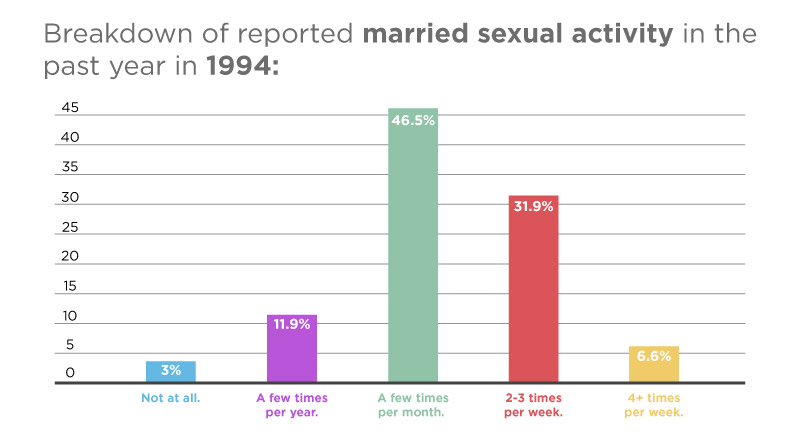
- A more recent survey shows some different numbers on sexual activity in married couples. (Mind Body Green, 2020)4
- Once per week – 25%
- 2-3 times per week – 16%
- 4+ times per week – 5%
- Once per month – 17%
- 2-3 times per month – 19%
- None in the past year – 10%
- 1-2 times in the past year – 7%
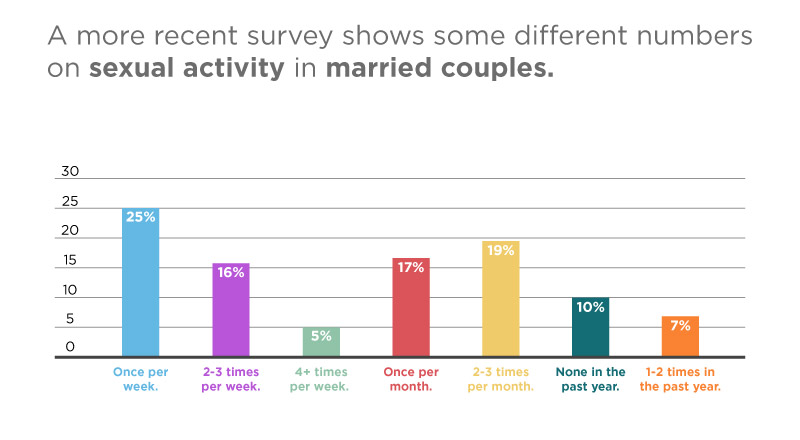
- Only 26% of couples are having sex even once per week, and most couples report having sex 1-2 times per month or less. (Healthline, 2018)5

How Often Should an Average Couple Have Sex?
While there isn’t a magic number for the perfect sex life, there is a minimum amount of sex that will increase personal happiness.
Take a look at this data point:
- An analysis of three studies finds that sex will make you happier up to a frequency of once per week. After that, more sex has no significant benefit on personal well-being. (SAGE Journals, 2015)6
The “Normal” Frequency of Sex in a Couple
Now that we know where the personal benefits begin and end, what is the “normal” or optimal level of sex for couples? The following data gives some clarification:
- Communication between partners determines the “normal” frequency of sex. This could be anywhere from several times a day to a few times per year. There is no correct amount of sex in a relationship as long as both partners are satisfied. (International Society for Sexual Medicine, unspecified)7
How Often Do People Actually Think About Sex?
Naturally, thinking about sex is tied to how often a person wants sex. While men and women generally differ, understanding these differences can help you improve your own sex life.
- Before age 60, most men think about sex at least once per day. Only a quarter of women claim to think about sex frequently. Sexual fantasies decrease with age, but men still fantasize about twice as much as women.
- In general, men crave sex more often than women at every phase of a relationship.
(WebMD, 2013)8
Married Couples: How Much Sex Do They Have in a Year?
Here’s a year-specific breakdown of how often married couples have sex, outlined from 1989 to 2014.
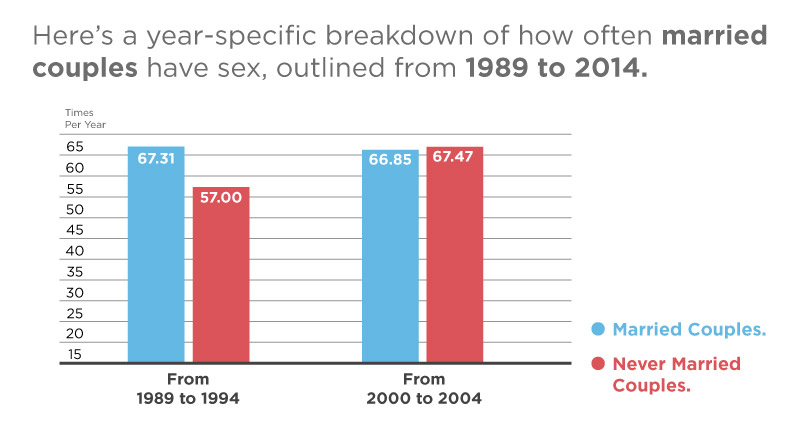
- In the 1990s, never-married individuals were having less sex than their married counterparts. By the mid-2000s, however, this trend was completely reversed. (Research Gate, 2017)9
- From 1989 to 1994, married couples had sex an estimated 67.31 times per year. Those who never married only had sex 57.00 times per year.
- From 2000 to 2004, married couples were having sex 66.85 times per year, while those who never married had increased their sexual frequency to 67.47 times per year
- Married couples with children under 18 had sex an estimated 69.54 times per year from 2010 to 2014. Here’s a breakdown of sexual frequency in married couples by year. (Research Gate, 2017)9
- 1989-1994 – had sex 74.92 times per year.
- 1995-1999 – had sex 74.19 times per year.
- 2000-2004 – had sex 75.65 times per year.
- 2005-2009 – had sex 75.84 times per year.
- 2010-2014 – had sex 69.54 times per year.
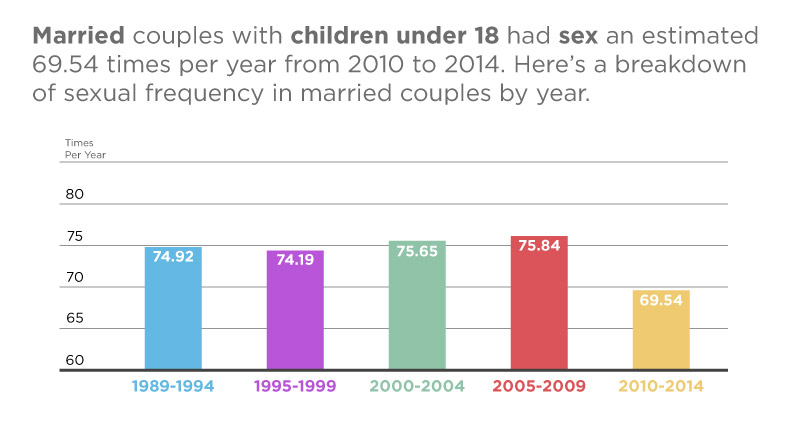
Importance of Sexual Intimacy in a Couple
There will always be certain times or phases when we don’t want to have as much sex. We can find ourselves wondering if sexual intimacy is truly important in a relationship.
These statistics demonstrate how sexual intimacy impacts a relationship:
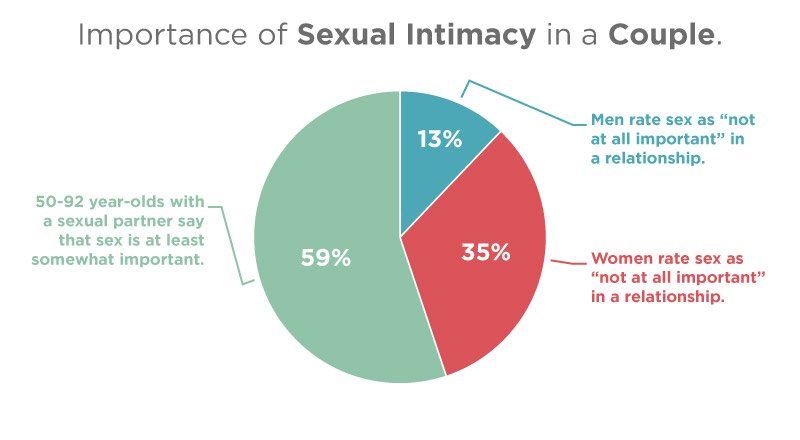
- Many couples say they don’t feel “intimate,” “close,” or “connected” – they also say a major cause of relationship problems is a lack of intimacy. (Ohio State University, 2013)10
- Only 13% of men rate sex as “not at all important” in a relationship, compared to 35% of women. (National Library of Medicine, 2008)11
- 59% of 50-92 year-olds with a sexual partner say that sex is at least somewhat important. (Research Gate, 2003)12
How Relationship Satisfaction Affects an American Couple
Everyone wants their relationship to be perfect, but getting there isn’t always clear. Prevailing research highlights two major factors: sexual satisfaction and open communication.
- In heterosexual married couples, husbands’ relationship satisfaction typically increases with their wives’ sexual satisfaction. (Journal of Sex & Marital Therapy, 2014)13
- Open and healthy communication about any topic – general or sexual – increases overall relationship satisfaction. Specifically, talking about sex can increase satisfaction in a relationship. (SAGE Journals, 2010)14
Sexually Satisfied Couples: How Many Are There?
In a time when fewer people are getting married or even getting together, it can be hard to tell if a relationship is the right choice at all. How many modern couples are staying sexually satisfied?
Here’s a look at the data:
- About half of Americans in relationships are currently satisfied with their sex life (55% of women and 43% of men). 27% of women and 41% of men are dissatisfied, and 18% of women and 16% of men are neutral. (Chapman University, 2016)15
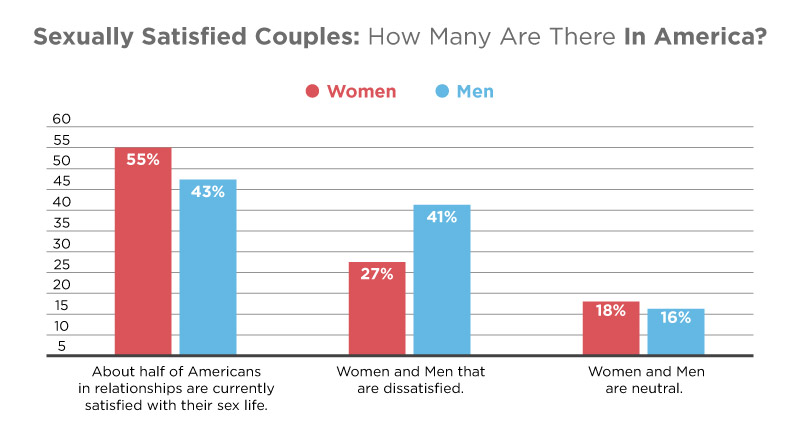
- Most men and women (83%) report being sexually satisfied in the first six months of their relationship. After three or more years together, only 55% of women and 43% of men said they were still sexually satisfied. (Chapman University, 2016)15
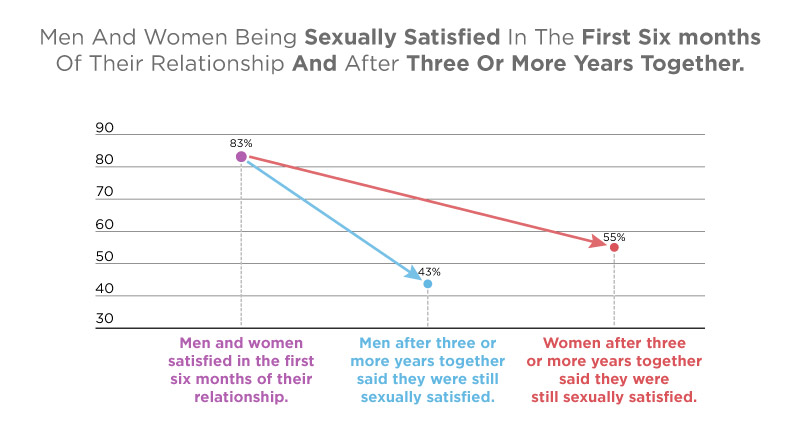
- In an Australian study, only 46% of men and 58% of women were satisfied with how often they were having sex. (Research Gate, 2011)16
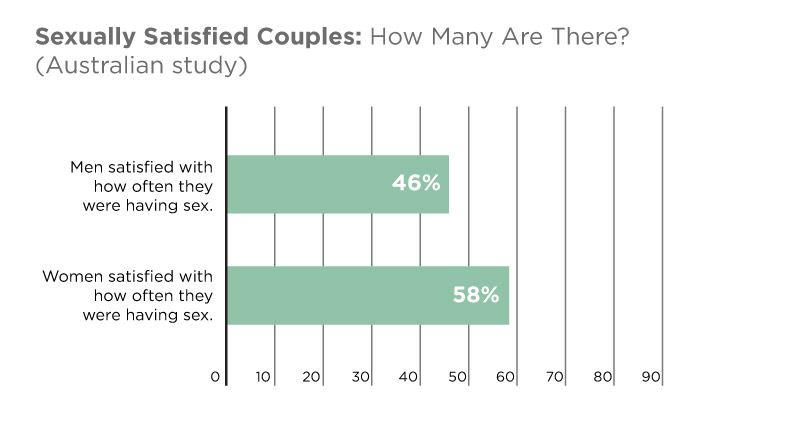
Reasons You Have Less Sex With Your Partner
Sometimes sex just doesn’t feel appealing. Some of us want to be in the mood but can’t seem to kindle the passions and desires we used to have.
Once we understand why passion fades, we can better understand how to bring it back. The following data explains why couples might be having less sex than they used to:
- Sexual frequency decreases for several reasons: aging, poor health, habituation (boredom or unexciting sex), pregnancy, small children, or sterilization. (Journal of Marriage and Family, 1995)17
- Over half of women (55.4%) want to communicate with their partner about sex but choose not to for several reasons: not wanting to hurt a partner’s feelings (42.4%), being uncomfortable talking about the details (40.2%), or feeling embarrassed (37.7%). (Springer Link, 2019)18
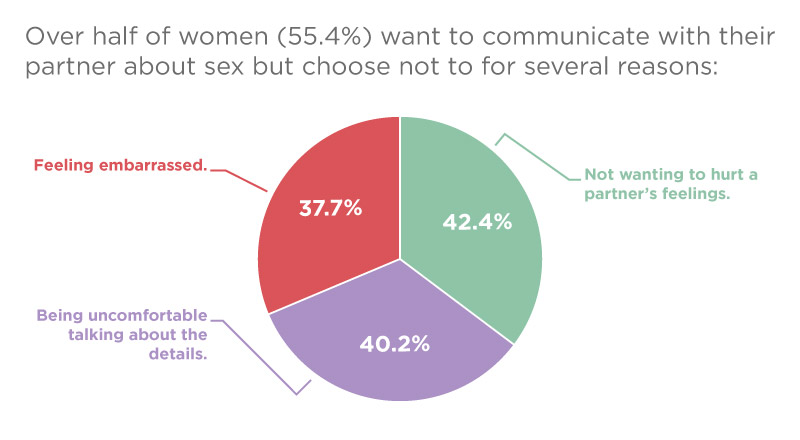
- For men, poor physical health is a major cause of less frequent sexual activity. (Oxford University Press, 2011)19
- American couples may have less time to engage in sexual activity than they used to due to longer work hours and more time spent with children. (Research Gate, 2017)9
Is There a Limit on Sex for Couples in a Day?
Can there be such a thing as too much sex? Here’s what the experts say:
- It’s normal and healthy for a couple to have sex as many times as they like. As long as it is consensual, non-pressured, and feels right, go for it! (Planned Parenthood, 2014)20
Conclusion
Sex can be the factor that makes or breaks any kind of relationship. While sexual activity in married couples is declining, and weekly sex can affect personal happiness, the truth is that every person approaches sex in their unique way.
There’s no magic number to sexual satisfaction. The most important aspect of a healthy sex life is open communication with your partner. Take a leap of faith and have a conversation about sex – you just might find that it builds intimacy with your partner and makes your experience more pleasurable.
Footnotes
- The American Journal of Psychiatry, 1994. An article on sexual behavior in America authored by Stuart Seidman and Ronald Rieder and published in the American Journal of Psychiatry. Hosted on APA PsycNet.
- National Library of Medicine, 2020. A study on sexual trends and activity in 9,504 adults compiled by Peter Ueda, MD, PhD, et al. and published by The Journal of the American Medical Association.
- The Social Organization of Sexuality: Sexual Practices in the United States, 1994. An informative text on human sexuality which cites a study of 905 married Americans, published by the University of Chicago Press.
- Mind Body Green, 2020. An informative article by sex educator and journalist Kelly Gonsalves, citing a 2018 General Social Survey on sexual activity in 660 married individuals.
- Healthline, 2018. An informative article authored by Heather Montgomery and citing David Schnarch, PhD, as he comments on the results of a study of 20,000 couples.
- SAGE Journals, 2015. A research article authored by Amy Muise, Ulrich Schimmack, and Emily Impett from the Department of Psychology at the University of Toronto, exploring the correlation between sexual activity and well-being among 30,645 Americans.
- International Society for Sexual Medicine, unspecified. A medically-reviewed article on the general average frequency of sex that couples engage in.
- WebMD, 2013. A medically-reviewed article on gender-specific sex drives that leans on the work of Edward O. Laumann, PhD, professor of sociology at the University of Chicago.
- Research Gate, 2017. A study of 26,620 Americans to analyze trends and determine causality of a decline in sexual frequency among U.S. adults.
- Ohio State University, 2013. A dissertation by Hana Yoo about the correlation between intimacy and satisfaction in a relationship that utilizes a study of 96 American couples for data.
- National Library of Medicine, 2008. A study conducted by Stacy Tessler Lindau, M.D., M.A.P.P., et al. on sexuality and health in 3,005 American adults published in the New England Journal of Medicine.
- Research Gate, 2003. A study on the importance of sex in the later years of life conducted on 44 UK citizens aged 50-92.
- Journal of Sex & Marital Therapy, 2014. A study conducted by Hana Yoo et al. on the sexual satisfaction of 335 American marriages and published in the Journal of Sex & Marital Therapy.
- SAGE Journals, 2010. A research article on the impact of communication on relationship satisfaction, written by Jennifer L. Montesi et al. and published in the Journal of Social and Personal Relationships.
- Chapman University, 2016. A study of 38,747 American who have been together for 3 or more years conducted by David Frederick et al. that aims to gauge sexual satisfaction in relationships.
- Research Gate, 2011. An Australian study conducted to gauge desired sexual frequency and sexual satisfaction in relationships in 8,656 men and women.
- Journal of Marriage and Family, 1995. An article based on a 1988 study of marital sex in 7,463 American adults published by the National Council on Family Relations.
- Springer Link, 2019. An academic article on a study of 1,008 American women authored by Debby Herbenick et al. about the factors influencing women’s sexual satisfaction (or lack thereof) and published in the Archives of Sexual Behavior.
- Oxford University Press, 2011. A study of the causes of sexual decline in 6,437 American men conducted in 2011 and published in the Journals of Gerontology.
- Planned Parenthood, 2014. A short article written by an expert responding to frequently asked sexual questions, specifically on whether or not it’s healthy to have sexual activity more than three times per day.